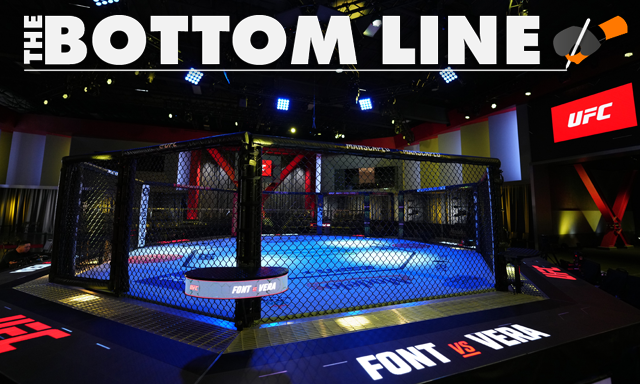The Bottom Line: An Inextricable Link

Editor’s note: The views and opinions expressed below are those of the author and do not necessarily reflect the views of Sherdog.com, its affiliates and sponsors or its parent company, Evolve Media.
Since the start of the coronavirus pandemic, a seeming contradiction has developed in the world of mixed martial arts. On the one hand, the Ultimate Fighting Championship’s pay-per-views are doing all-time record business. The company’s top drawing cards have retained or increased their appeal while business for mid- to low-level stars has gone up significantly. Quick sellouts are the norm, and the UFC is bringing in the most money it ever has for parent company Endeavor. MMA’s biggest events are thriving.
At the same time, interest in rank-and-file MMA shows is at a low ebb. The UFC’s weekly ESPN+ offerings come and go with little discussion. Even a memorable fight like Marlon Vera-Rob Font from UFC on ESPN 35 tends to generate little attention outside of diehard MMA fan circles. Worse still are the ratings for other organizations, which struggle to generate viewership even for their biggest fights. Oddly, MMA is simultaneously red hot and ice cold.
Advertisement
When MMA exploded in popularity a decade and a half ago, the excitement surrounding MMA stemmed in part from its rarity as a television event. The UFC only ran around 10 pay-per-views a year and Spike TV meant another six or seven shows would run on cable TV. Showtime would soon begin running another half dozen or so major events a year. All these shows had fewer fights than is standard now, and not all of those bouts were televised. MMA at that point had a smaller base of converts, but because the sport was so easily digestible, a big percentage of those converts consumed everything. The floor for the UFC on pay-per-view was higher then than it would be 10 years later when there were many more people who would sometimes order events.
Over time, the UFC and its competitors sought to capitalize on MMA’s growing popularity by running more and more events on television. It meant large television rights fees, but it also saturated and then oversaturated the market over time. The UFC in particular lost one of its big early advantages: the depth of its cards. Back in 2006 and 2007, UFC President Dana White would regularly trumpet the fact that compared to a major boxing event with one or maybe two fights of note, the UFC would provide an evening of major, consequential bouts. Even if the main event was disappointing, odds were good that you’d have experienced an exciting fight or two before that.
Running a stacked pay-per-view every time out became untenable because the UFC was running so often and needed to deliver major fights to the paying fans attending weekly television bouts around the world. That was until the pandemic hit and the UFC did not need to worry about an event at the UFC Apex with no real fights of interest to the general public. Pay-per-views became the only real priority, and this allowed pay-per-views to become must-see attractions pretty much every time once again.
The last month is instructive. Over the past three weeks, the UFC ran the UFC Apex with three quality main events: Vicente Luque-Belal Muhammad, Amanda Lemos-Jessica Andrade and Font-Vera. After those three fights, there was not much in the way of consequence in the near- to medium-term. Meanwhile, there are two title fights this Saturday at UFC 274, including a scintillating matchup between Charles Oliveira and Justin Gaethje. The rest of the pay-per-view is loaded with star power: Michael Chandler-Tony Ferguson, Mauricio Rua-Ovince St. Preux and Donald Cerrone-Joe Lauzon. That’s at least two surefire hall of famers, an interim UFC champion and a multiple-time Bellator champion. To be sure, UFC 274 is a particularly strong card, but it is not far from the norm when it comes to UFC pay-per-views the past couple years.
The reality is that while there are some of us who love the sport enough to watch over 70 events a year—like the UFC, Bellator and PFL combined to produce in 2021—that base is limited. When it’s not clear which events are worth watching and which aren’t, people give up. Over the past couple years, the UFC has made it easy again. The company doesn’t advertise it explicitly, but clearly people are figuring it out: Watch our monthly pay-per-view and maybe an ESPN+ main event here and there and you’ll basically be caught up on the major happenings in the sport. It’s expensive, but it’s no longer daunting from a time perspective.
There are ways to generate more interest in rank-and-file MMA shows. Make no mistake, however, the greater the efforts in that direction, the harder it will be to sustain the increased interest in the sport’s biggest events. That’s not simply because resources need to be diverted from the biggest shows to build up the lesser ones, but also because there is only so much product a large base of people are willing to follow. That’s the big advantage the NFL has over other sports, and it’s an advantage UFC is rediscovering. The UFC needs to run the extra shows for the rights fees, but those shows are increasingly becoming supplemental content. That’s not a problem; it’s a positive feature.
« Previous Joaquin Buckley vs. Albert Duraev Announced for UFC on ESPN 37 in Austin
Next Video: UFC 274 ‘Embedded’ Episode 2 »
More




 UFC News & Features
UFC News & Features



